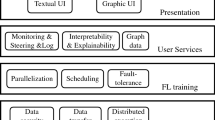Abstract
The landscape of machine learning is changing rapidly due to the ever-evolving nature of data and devices. The large centralized data is replaced by the distributed data and a central server is replaced with a large number of geographically distributed, loosely connected devices, such as smartphones, laptops, and other IoT devices. Therefore, the centralized machine learning (CML) which involves centralized data training on a central server is no longer an effective solution when the data is inherently distributed or too big to process on a central server, or data privacy is paramount; and the quest for a suitable machine learning to resolve these issues led to the evolution of distributed machine learning (DML). For large-scale learning tasks, DML has evolved to effectively handle enormous data within big data and distributed computing environment. Resolving most limitations faced by CML with the implementation of parallel learning on a large number of nodes to optimise time, learning resources and performance. However, DML may not necessarily ensure strict data privacy leading to further development and innovation of federated machine learning (FML) which is a type of DML that further decentralizes learning operations using local data on each participating node incorporating data privacy adherence. This paper analyses the transformation journey of machine learning whilst explaining its evolution from centralized, distributed to federated machine learning. Examining these three variants of machine learning exemplifies their coherent and comparative analysis. Which helps grasp a better understanding of each machine learning type as well as presenting the reason for the changing landscape. Additionally, the paper will address each type of machine learning alongside their different types, strengths and limitations.
Access this chapter
Tax calculation will be finalised at checkout
Purchases are for personal use only
Similar content being viewed by others
References
Kairouz, P., McMahan, H.B., Avent, B., Bellet, A., Bennis, M., Bhagoji, A.N., Bonawitz, K., Charles, Z., Cormode, G., Cummings, R., et al.: Advances and open problems in federated learning. Found. Trends Mach. Learn. 14(1–2), 1–210 (2021)
Kamp, M.: Black-box parallelization for machine learning. Ph.D. thesis, Universitäts-und Landesbibliothek Bonn (2019)
Liu, J., Huang, J., Zhou, Y., Li, X., Ji, S., Xiong, H., Dou, D.: From distributed machine learning to federated learning: a survey. Knowl. Inf. Syst. 64(4), 885–917 (2022)
McMahan, B., Moore, E., Ramage, D., Hampson, S., Arcas, B.A.: Communication-efficient learning of deep networks from decentralized data. In: Artificial Intelligence and Statistics, pp. 1273–1282. PMLR (2017)
McMahan, B., Ramage, D.: Federated learning: collaborative machine learning without centralized training data. https://ai.googleblog.com/2017/04/federated-learning-collaborative.html (2017)
Microsoft.com: Distributed training with Azure Machine Learning. https://learn.microsoft.com/en-us/azure/machine-learning/concept-distributed-training?view=azureml-api-2 (2023)
Naik, D., Naik, N.: An introduction to federated learning: working, types, benefits and limitations. In: UK Workshop on Computational Intelligence (UKCI). Springer (2023)
Verbraeken, J., Wolting, M., Katzy, J., Kloppenburg, J., Verbelen, T., Rellermeyer, J.S.: A survey on distributed machine learning. ACM Comput. Surv. (CSUR) 53(2), 1–33 (2020)
Author information
Authors and Affiliations
Corresponding author
Editor information
Editors and Affiliations
Rights and permissions
Copyright information
© 2024 The Author(s), under exclusive license to Springer Nature Switzerland AG
About this paper
Cite this paper
Naik, D., Naik, N. (2024). The Changing Landscape of Machine Learning: A Comparative Analysis of Centralized Machine Learning, Distributed Machine Learning and Federated Machine Learning. In: Naik, N., Jenkins, P., Grace, P., Yang, L., Prajapat, S. (eds) Advances in Computational Intelligence Systems. UKCI 2023. Advances in Intelligent Systems and Computing, vol 1453. Springer, Cham. https://doi.org/10.1007/978-3-031-47508-5_2
Download citation
DOI: https://doi.org/10.1007/978-3-031-47508-5_2
Published:
Publisher Name: Springer, Cham
Print ISBN: 978-3-031-47507-8
Online ISBN: 978-3-031-47508-5
eBook Packages: Intelligent Technologies and RoboticsIntelligent Technologies and Robotics (R0)




